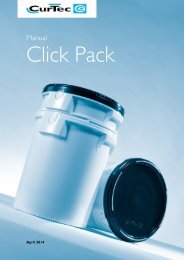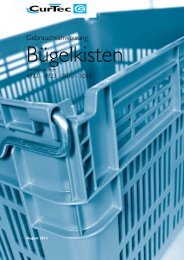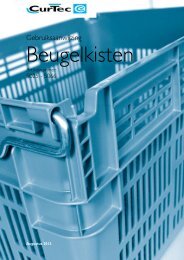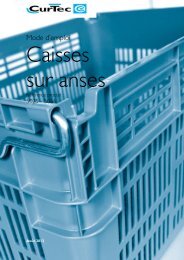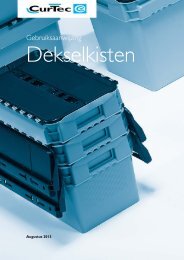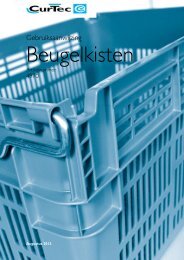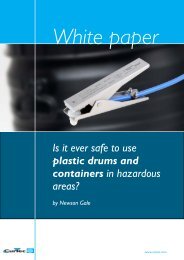You also want an ePaper? Increase the reach of your titles
YUMPU automatically turns print PDFs into web optimized ePapers that Google loves.
Manual<strong>Swingbar</strong><strong>crates</strong>Product code:4971 - 4972 - 4973 - 4974August 2013
010_UKCleaning instructionsThe following cleaning instructions apply to all CurTec products made of polyethyleneand polypropylene.• The best results are obtained by using an industrial washing installation equippedwith sprinklers or by using a so-called Ultra-Sonic installation.• The most suitable detergent is a low-foam alkaline product with a pH value of 10 to12 (in solution).• The recommended temperature of the washing water is between 40 °C and 50 °C.• The temperature of the rinsing water should be no higher than 65 °C.• The washing cycle at the above temperature should last no longer than 35 seconds.The final rinse at the temperature mentioned should take at most 20 seconds. Thisprevents the plastic from fully heating up and displaying signs of shrinkage.• Assisted drying of the products can be done with a cold air stream. When usingheated air, assisted drying should last no longer than 30 seconds at a temperature ofno more than 65 °C.• The assisted drying and drying areas of the installation should be adapted to theproduct, so that poorly accessible parts of the product are also dried.• For specific technical information, you are advised to consult the various suppliers ofindustrial washing installations. CurTec can offer assistance.Note: You should regularly check the thermostats and the time settings of yourequipment.
016_UKPalletisingThe <strong>crates</strong> should never be put under a heavier load than prescribed in theseinstructions. The swingbar <strong>crates</strong> should be stacked in accordance with instruction040_UK. When stacking the <strong>crates</strong>, the weight of a stacked crate is supported by theswing bars of the crate below. It is essential that the four corner portions (the stackingprofiles) of the lowest crate in a stack are properly supported by a pallet, spacer board orbottom board.F1 F1 shows the stacking of swingbar <strong>crates</strong> (600 x 400 mm) on a pallet of 1000 x 1200mm.F2 shows the stacking of swingbar <strong>crates</strong> (600 x 400 mm) on a pallet of 800 x 1200mm.The thickness of the top deck boards on reusable pallets should be at least 20 mm.Disposable pallets should have top deck boards with a thickness of at least 15mm andshould not be stacked when loaded.F2Caution!!The <strong>crates</strong> should not protrude by more than 10 mm beyond the pallet. For that reason,we recommend that spacer boards are made ±15 mm longer and wider than indicatedalongside. This offers a little more leeway when stacking.If you intend to stack <strong>crates</strong>, you should have pallets of adequate strength. With weakpallets, the <strong>crates</strong> may become distorted as illustrated in the bottom figure. As a result,the <strong>crates</strong> will not be optimally supported and the stacking load may be exceeded.When stacking several pallets on top of each other, the bottom deck of the pallet to bestacked should be identical to the top deck of the pallet below.If the bottom deck is not identical to the top deck, use a spacer board. All the stacks of<strong>crates</strong> on the bottom pallet must be equal in height. All the <strong>crates</strong> on the bottom palletmust be of the identical type. The materials and finishing of the pallet must be of a highstandard. Disposable pallets should not be used when stacking loaded pallets.The top pallet must be adequately supported by the corner portions of the <strong>crates</strong> on thebottom pallet. For the permissible stacking heights of <strong>crates</strong>, see the appropriateinstructions.
023_UKStacking/nestingWhen stacking these <strong>crates</strong>, the bars should be folded inward, as shown in F1. If a lid isused, the lid should be placed on the crate first and then the bar should be folded in.The bottom of the crate stacked on top will be supported by the bar.F1Crates 4971 and 4972 can be interchangeably stacked/nested. Crates 4973 and 4974can likewise be interchangeably stacked/nested.Caution!!During nesting make sure that all <strong>crates</strong> have the same dimensions, length, width andheight.When nesting, i.e. fitting empty <strong>crates</strong> into each other, the bars should be foldedoutward. This is shown in F2. You should ensure that the smaller <strong>crates</strong> are placed in thelarger-sized <strong>crates</strong>.F2The swing bar <strong>crates</strong> can be moved easily by hand. You can lift them along the edges,by the handles - if present - or by the bars. See F3..F3
024_UKWeight and capacityThe following table lists the weight of the crate and the corresponding maximum weightof the content. The weight of the crate content should be spread across the bottom asevenly as possible. Depending on the weight, the temperature and the time interval, thebottom of the crate may sag somewhat. After the crate has been emptied, the saggingwill fully or partially disappear.Crate nr. Capacity Weight of crate Max. weight content4971 20 L open 2,45 kg 25 kg4972 20 L closed 2,70 kg 25 kg4973 40 L open 3,00 kg 35 kg4974 40 L closed 3,35 kg 35 kgT1In T2 the maximum number of <strong>crates</strong> is shown which can be stacked up to 198 cm.(incl. pallet). In addition, the maximum load on the bottom crate is shown at themaximum weight of the content indicated in T1.Instruction 040_UK describes how long such a stack can be left standing..Crate nr. Max. number <strong>crates</strong> in stack Max. load on bottom crate in stack4971-4972 13 325 kg4973-4974 7 245 kgT2Caution!The <strong>crates</strong> can be used for the storage of goods at temperatures between -35°C and+35°C. At temperatures below -10°C, knocking and impact strains should be avoided.Normal road transport is possible, provided the following requirements are met:• The pallets must be loaded in accordance with these instructions.• The total driving time must not exceed 25 hours.• The temperature in the loading area during transport must not exceed 35°C.• The load on the bottom crate must not be greater than175 kg. (in accordance withTable 2)
025_UKStackingThe maximum load-bearing capacity of the bottom crate in a stack is dependent on:• The number of <strong>crates</strong> in the stack• The weight of the content of each crate• The ambient temperature• The time interval during which the stack is left to stand• The surface on which the stack is placedT1 gives a summary of the maximum load-bearing capacities of the bottom crate at theambient temperature and time interval indicated, whilst stacked on a hard surface or onpallets in accordance with instruction 016_UK.4971 & 4972 4973 & 4974Temp. Time in months Weight on bottom crate Max. stacking height Max. stacking height<strong>crates</strong> metres <strong>crates</strong> metres½ 550 kg 21 3,20 15 4,101 500 kg 19 2,90 14 3,90≥ 0°C3 450 kg 17 2,70 12 3,406 410 kg 16 2,50 11 3,1012 380 kg 14 2,20 10 2,90½ 300 kg 12 < 1,98 8 2,401 275 kg 11 < 1,98 8 2,4020°C3 230 kg 10 < 1,98 7 < 1,986 225 kg 9 < 1,98 6 < 1,9812 200 kg 8 < 1,98 6 < 1,98½ 200 kg 8 < 1,98 6 < 1,9835°C1 180 kg 7 < 1,98 5 < 1,983 160 kg 7 < 1,98 5 < 1,98T1• The maximum stacking height should not exceed 6 metres.• For stacks higher than 3 metres, the floor slope should not exceed 0.5%.• In stacks of more than two pallets or higher than 4 metres, the <strong>crates</strong> should bestrapped.If stacks of <strong>crates</strong> are to be transported after long-term storage, the <strong>crates</strong> must first berestacked. This means that the bottom crate of the stack has to become the top crate andthe original top crate has to move to the bottom. If the <strong>crates</strong> are to be stored again aftertransport, the <strong>crates</strong> have to be restacked once more..
100 Inside SalesCurTec InternationalSpoorlaan Noord 925121 WX RijenThe NetherlandsUK & Ireland: +44 20 3514 4624North America: +1 908 450 98 16All other countries: +31 88 808 2000curtec.en@curtec.comwww.curtec.com




